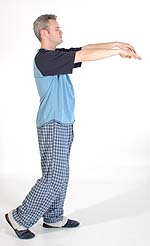Sleepwalking: Causes, Symptoms
and Treatment

Sleepwalking is a sleep disorder during which a person partially awakes and does things associated with being awake.
What Is Sleepwalking?
Sleeping is associated with several stages ranging from drowsiness to deep sleep. While sleeping a person moves through 5 stages. This makes up a sleep cycle. There are two broad categories associated with a sleep cycle: Rapid eye movement (REM) and non rapid eye movement (NREM). Sleepwalking happens during NREM. It usually occurs during the first 2-4 hours of sleep. Sleepwalking entails more than just walking. It ranges from walking around to driving to doing inappropriate things (like urinating in a closet). The person will have no recollection of the episode in the morning.
Causes:
Sleepwalking is more common among children than adults and it tends to be genetic. The exact cause is unknown, but it has been observed in children who:
- Are overtired.
- Are anxious or stressed.
- Have irregular sleep pattern.
- Are ill or has a fever.
Symptoms:
- Getting out of bed and walking around, while still asleep.
- Open eyes, but the person has a 'glazed over' look.
- Person is slow to respond or non-responsive.
- Confused and disorientated upon awakening.
- Incoherent talking.
- Repeated motions like rubbing eyes or fumbling with clothes.
- Clumsiness.
- No recollection in the morning.
Associated Medical Conditions:
- Abnormal heart beat.
- Fever.
- Nighttime asthma.
- Nighttime seizures.
- Interrupted breathing.
- Bedwetting.
Possible Complications:
Sleepwalking in itself is not harmful, however it can be dangerous. Sleepwalkers are asleep and do not realize what they are doing. They walk down stairs, go outside and some even drive. Sleepwalkers can get injured by stumbling over things, falling down stairs or even out of a window.
Treatment:
There is no medical treatment available for sleepwalking; however, there are some precautions you can take:
- Sleepwalkers shouldn't sleep on top bunk beds.
- Lock doors and windows and hide car keys.
- Remove obstacles from the room.
- Sleepwalkers should sleep on the ground floor if possible.
- Place an alarm or bell on all doors that lead outside.
Sleepwalkers should not be awakened, because they will be disorientated and confused, however, it is not dangerous or harmful to wake them up. It is advisable to simply guide the sleepwalker back to bed. You can also do scheduled awakening. This entails fully awakening the sleepwalker 15 minutes before they usually sleepwalk. Scheduled awakening disrupts the sleep pattern. The person can go back to sleep after about 5 minutes.
|